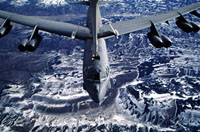|
From its earliest days, the B-52 rapidly proved itself. Indeed, the plane was the very heart of the Strategic Air Command (SAC) for most of its existence. Able to strike distant targets with pinpoint accuracy, the plane was soon christened "SAC's Long Rifle."
To prove the capabilities of the bomber, on January 10-11, 1962, a Minot AFB-based, 4136th Strategic Wing B-52H set a new distance in a straight line world record. It flew unrefuelled 12,532 miles from Kadena, Okinawa, in the Pacific to Torrejon AB, Spain, on the outskirts of Madrid. By 1963, SAC operated 650 B-52s. Fully 42 squadrons were based at 38 air bases around the United States. From these sites, with air refueling and stops at bases in the South Pacific like Andersen AFB in Guam, the B-52s could strike virtually any target in the Soviet Union. This protective umbrella, based on the philosophy of deterrence through Mutually Assured Destruction (MAD), would remain in place until the early 1990s, when the fall of the Soviet Union rendered it unnecessary. |
 Within six years of its initial deployment, SAC ordered its force of B-52s to be ready to fly round-the-clock operations armed with nuclear bombs. An airborne command post was launched and, with rotation, was in the sky 24 hours a day for the next thirty years, ready to command an entire war.
Within six years of its initial deployment, SAC ordered its force of B-52s to be ready to fly round-the-clock operations armed with nuclear bombs. An airborne command post was launched and, with rotation, was in the sky 24 hours a day for the next thirty years, ready to command an entire war.